
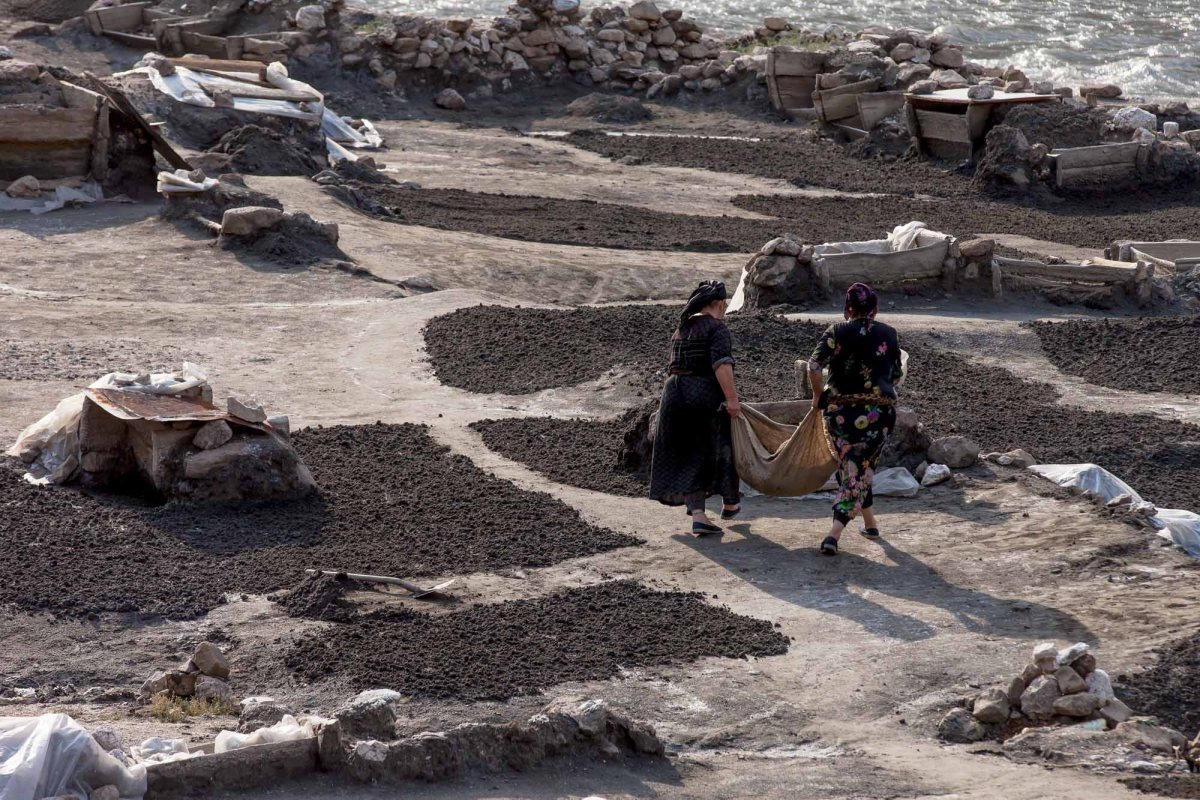
The women of Kvankhidatli, a village in the mountains of south-west Daghestan, are known as the people who mine salt. The women recall gathering sand by hand to dissolve the salt since the beginning of the 20th century but say the tradition is now dying out.
A handful of women in dark clothes bypass the fields of black sand scattered along the river bank. The sand is lumpy — small grains of salt glisten in the sun. Women collect the sand, placing it in a large wooden box. When enough sand has been collected, they will fill the box with water from the river. This will dissolve the salt, causing it to come out. The salty concentrate that is left is muddy and it must be allowed to settle.
Carefully, so as not to disturb the sediment, the water is drained into small buckets and carried in the direction of a dilapidated canopy. In the corner is a stone grill, which they call the boiler. On the stone slabs lies a huge baking tray, which can accommodate five buckets of salty concentrate. Under the stones, they make a fire and boil the salt. After three to four hours, the salt is almost ready.
Today there are four women, but usually, there are five working here. ‘Khadizhat was unwell’, says Rukiyat.
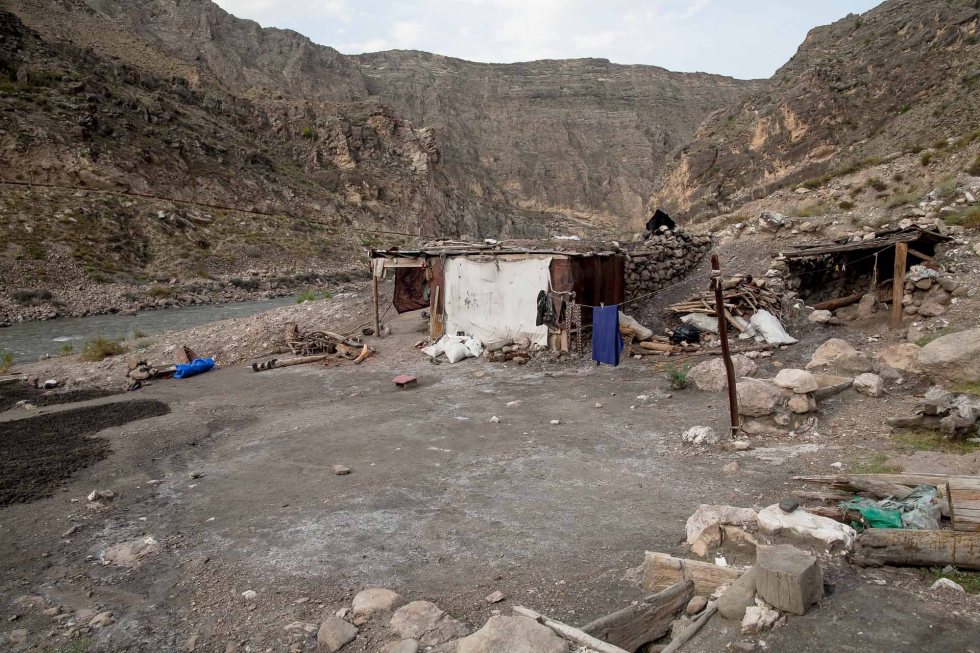
The women knead the sand without gloves, their gold rings glittering. In the mountains, it is not customary to take rings off, even if you are doing a dirty job. Gold is not cherished by the women because they do not cherish themselves.
Rukiyat pulls a handkerchief over her forehead — the sun blinds her eyes.
Asked why the men don’t help, she replies: ‘my son sometimes comes when we need help with heavy things: he brings firewood, chops it here, and takes the salt to the village. He has his own work, his own family. Khadizhat’s husband helps her; he is with her every day.’
‘I would not want my daughter to come here’
It’s two kilometres to the village along a narrow path under the scorching sun.
‘I work for five months, from May to September, and rest the rest of the time. I don’t even have a cow, only a garden and that’s it. In summer the work goes well, but it’s very hot and hard when the salt is boiled. In May and September it’s easier, because [in other months] the rain and dew are strong — everything deteriorates’, Batuli complains.
‘I studied very well, but as soon as I graduated from school, I was forced to get married’, she recalls. ‘I wanted to study. But my father didn’t let me. I married a tractor driver. I was married for 20 years, but now I’m alone.’
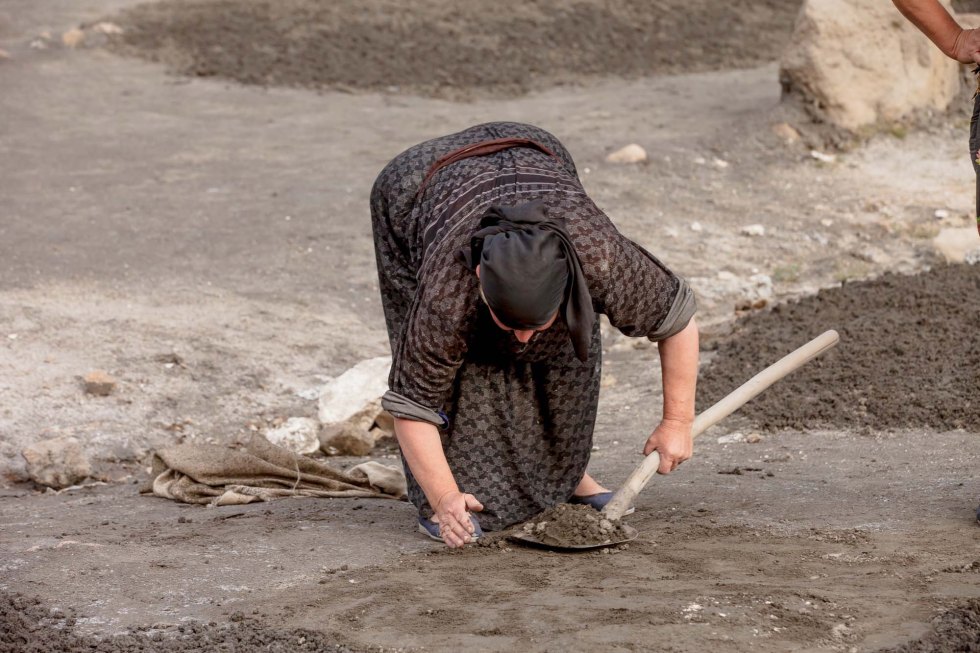
‘I never thought that I’d would work with salt. I feel very sorry that this business was abandoned, but I would not want my daughter to come here and she herself will never come. Even if there was nothing to eat, she would not come anyway. Young people don’t want to come and work here! They are not even interested, they don’t want to hear about it.’
Batuli says that this season, she worked with her aunt and collected more than 20 bags of salt; they will share them equally. They can get ₽9,000–₽10,000 ($130–$150) per bag.
In the meat salting season, wholesalers come to the village; then it’s possible to make a lot of money, which is impossible to collect by selling salt in small jars.
‘One Moscow entrepreneur became interested in our salt. Khadizhat’s husband negotiated with him to sell our salt in beautiful packaging in Moscow. Let’s see what happens’, Zagrabika, Khadizhat’s aunt, says.
Salt of the earth
‘We lived in prosperity, we never went hungry — salt helped us out. I’m telling you, if you meet a Kvankhidatlian, he is proud. Why? He did not starve. They took the salt to the mountains, and in the autumn, they drove back fat-tailed rams. We dried the meat — we could buy half of the gardens from our neighbours for them’, says Gadzhimurad, Khadizhat’s husband.
In the mountains, not every village can boast that ‘we never starved’. In lean years, artisans coped by fishing, hunting, foraging and collecting salt.
‘The demand [for salt] was so great that they didn’t have time to boil [the salt water]. Buyers stayed in the village for several days, waiting for their turn’.
In the past, boilers stood in every home. Wineskins with salt concentrate were brought home on donkeys and mules. They boiled the salt more often at night; during the day, men went to the forest for firewood and women worked the land.
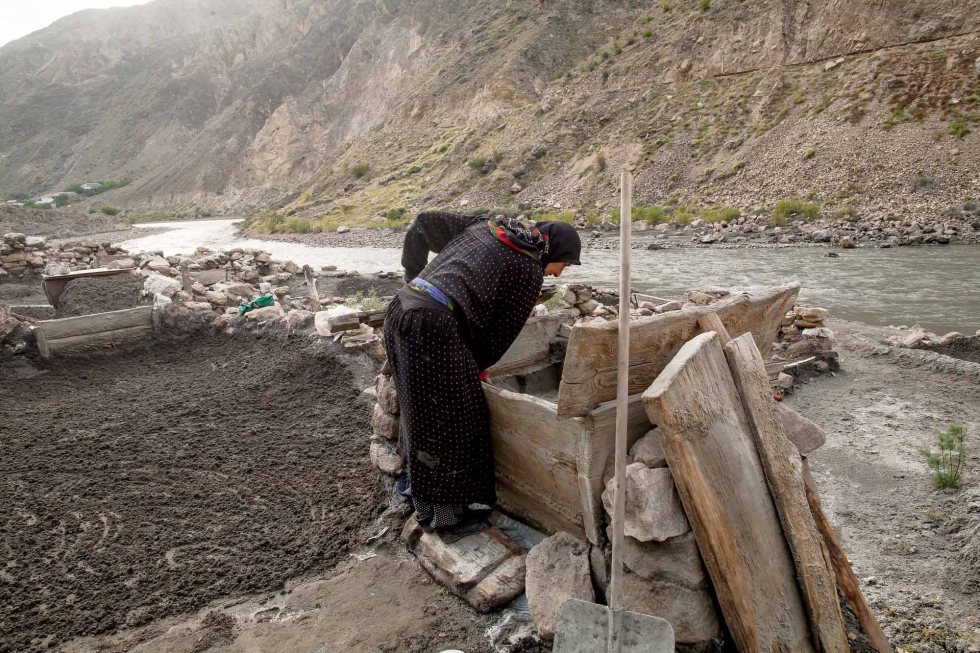
After the 1917 revolution, the price of salt depreciated — it cost a penny in stores. But those who understood did not buy cheap salt.
‘They bought ours — it’s light. If you try it on the tongue, our salt has a sour taste, the salt produced by the state had a bitterness to it,’ says Gadzhimurad.
In those years, the Kvankhidatlians set out to sell salt. Carts were equipped: a rider rode ahead, several loaded mules hitched behind his horse. They headed to Grozny, Vladikavkaz, and even further, reaching Georgia and Azerbaijan.
When they founded the Michurin collective farm, people reluctantly began to join: they were more accustomed to producing salt than farming. Moreover, there was no profit from farming. In 1935, the Baydukov salt-producing crew was formed, and people returned to their previous line of work, though it was hard work.
‘The work crew worked for two years and then closed. Why?’ Gadzhimurad asks thoughtfully. ‘Because the whole forest had been cut down. There was a plan to produce a tonne of salt per month. To do that, you needed a lot of firewood.’
‘The young had abandoned everything’
When the village was forcibly resettled to neighbouring Chechnya after the 1944 deportation of the Chechen people, Gadzhimurad was two years old. He strokes his face with a rough palm, diligently selecting his words:
‘They gathered literally everyone for the announcement. The sick, the young, the elderly, the feeble, all, without a difference, were driven on foot through the Andi mountains. It was a pity to leave the salt — it might spoil. People still hoped to return to their homes, so they entrusted their salt to Kunaks from the neighbouring village of Inkhelo’.
Two years after the expulsion, Gadzhimurad’s father, a specialist in the timber industry, was asked to return. Four years later, another 30 of the best log drivers, who transported logs downriver from where they were cut, were allowed to return with their families.
‘There was no news about my father. We didn’t even know what had happened to him. He just left and that was it. Everyone else remained in the Vedeno District [of Chechnya] until the return of the Chechens [in 1957]. The military was strict, no one returned ahead of schedule’.
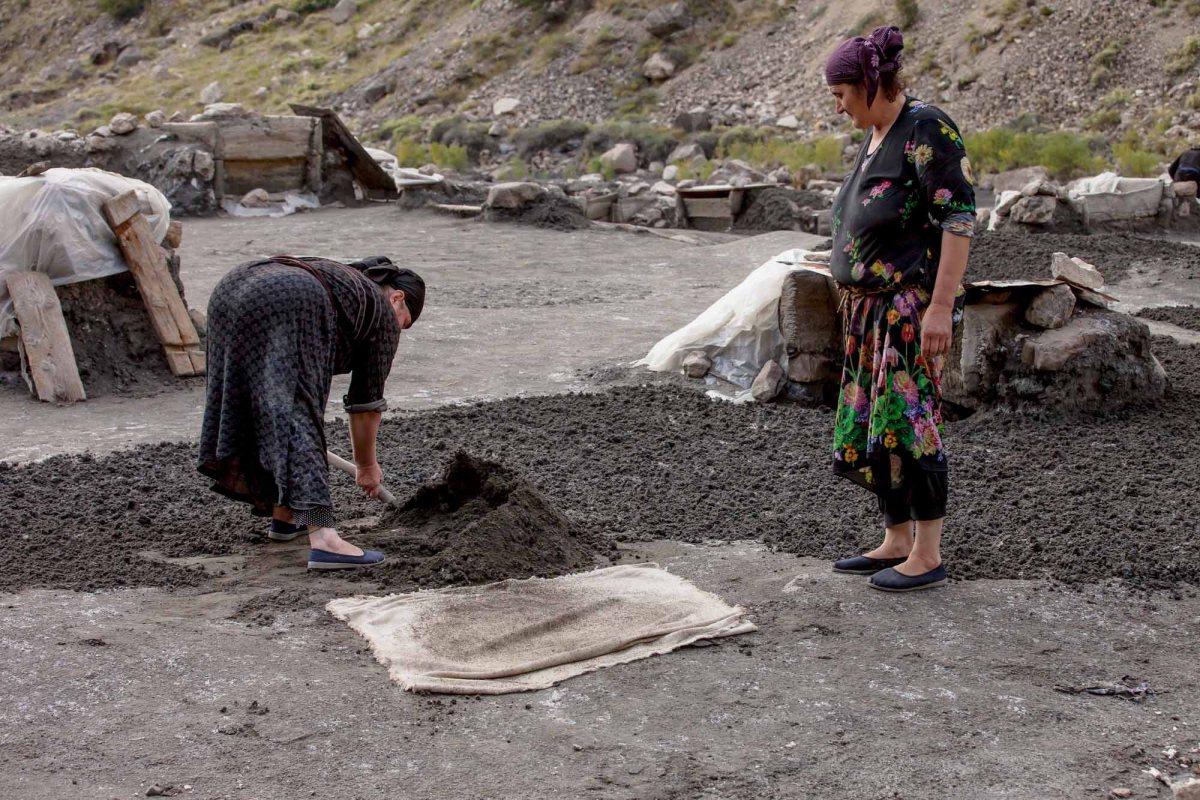
‘When the Chechens began to return to their homes, some of the villagers did not return and instead settled in the lowlands. In 1970, a highway was built through [the village of] Kvankhidatli’.
‘The young had abandoned everything’, recalls Gadzhimurad. ‘What salt? Donkeys, mules – they sold everything, bought cars, bought motorcycles. In short, they restructured. Now family allotments at salt sources are completely empty, no one wants to do hard work, neither my children nor others. In Astrakhan, Stavropol, and Kalmykia, they lease land, grow good crops, and earn twice as much. Why do they need this salt?’
Gadzhimurad says they have received an offer to sell salt through a network of farm stores. He hopes to launch a trial batch of salt under the ‘Kvankhidatlinskaya’ brand.
‘People need to be interested. If is there’s demand and villagers see that they can make good money from the salt, they will return to the salt.’
‘I will work on the salt and help you, mother’
Khadizhat is 78. She was born during the forced relocation of the villagers to Chechnya. She was lucky; she returned earlier than expected because her father was called to the forestry service.
As far back as she can remember, she has mined salt; she has never had another profession. Neither has her mother, her grandmother, or any other woman in her family. While she lived with her parents, she had nothing of her own: no plot of land, no salt, and no money.
‘That’s the way it was — it was that way for everyone, and at the age of 25, I got married and started working for myself’.
When a woman gets married, her parents select a part of the family’s salt areas to give to her.
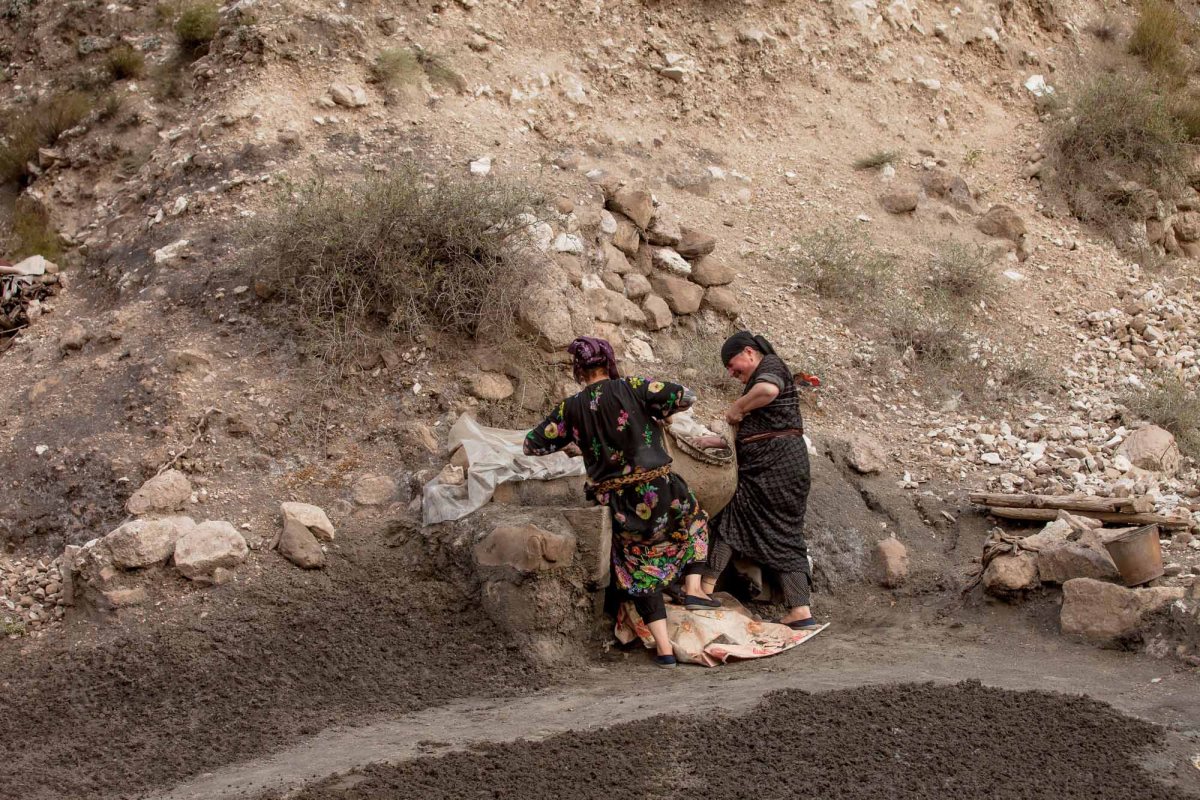
‘My plot of land was the size of this rug’, she says, pointing to the small rug under her feet.
This plot of land for salt mining, as well as other real estate received from a girl’s parents, remains with the woman no matter if she is married or divorced. In former times, the cost of a good, fruit-bearing garden could be gained for a small plot of land by the river.
‘My eldest daughter came to help me in the summer. She promised to come back for good; she said “I will work on the salt and help you, mother” ’, Khadizhat says with hope in her voice.
Women on the shore say they do not want their children to go working with the salt.
‘Do not believe them,’ says Gadzhimurad sharply. ‘This is what they say, they are just not comfortable. They do want them to, but they still will not come’.
‘We went to the salt together’
The technology of salt extraction has not changed over the centuries; it can be restored but experience is important here. As Khadizhat assures, one has only to abandon it and there will be no salt. But there is no help, a woman complains.
‘We have been asking for many years to build a road to the salt springs, at least a dirt road so that a scooter could be driven’.
‘No one needs this, the head [of the village] has a salary — he doesn’t think about us’, confirms her husband, Gadzhimurad. ‘If a person’s soul doesn’t hurt, he will not do anything’.
Asked if her husband helped her with her work, Khadizhat says that ‘now he helps a lot, and in the past, he did also, but before he was at home rarely’.
‘My mother-in-law was a very good woman, she helped with the children all the time and we “went to the salt” together,’ recalls Khadizhat.
Helping women at the salt plots was the order of things. But there was never a time that a man would mine salt alone among the women. He would be laughed at.
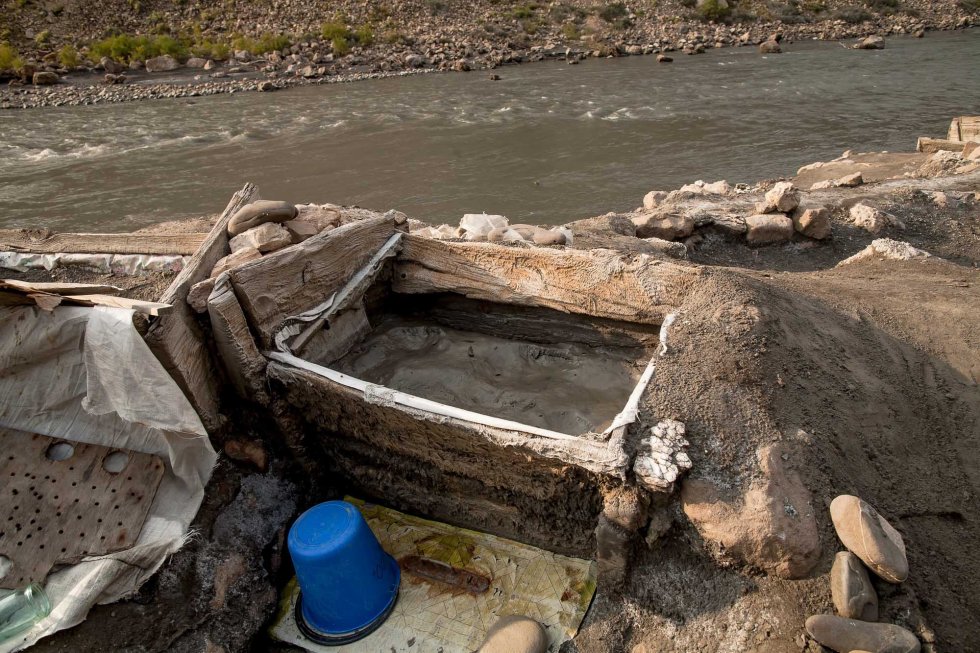
Kneading the sand in saltwater, collecting the sand, putting it in boxes and pouring it with water from a spring is a woman’s job. To chop wood, transport it to the village, prepare firewood, and to deliver the wood is a man’s job. Salt was boiled down by women, and men carried the salt on their shoulders or used donkeys.
‘When my mother could not keep up, my father, who had rheumatism, did not sleep at night and cooked salt to help her’, says Gadzhimurad.
Kvankhidatli is old-fashioned. Natives of the village keep in touch with the ancestral village. Children, as a rule, are sent to the mountains to visit their grandparents during the summer holidays. On religious holidays, everyone comes to the village — elderly relatives live here, ancestors are buried here, there are houses built by great-grandfathers. Any joyful or tragic events in the village require a presence. Not coming to a wedding or a funeral means showing disrespect.
The village survived for many centuries thanks to the salt industry. The villagers are known as the people who mine salt, not the people who cultivate vegetable gardens.
Even when their children tell them ‘leave this hard work, we will provide for you’, the salt miners do not agree — they do not know how to live differently. This is how their world works.
This article is a partner post written by Rita Roytman. The original version first appeared on Daptar, on 20 December 2018.






